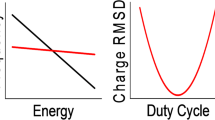Abstract
The Planar electrostatic ion trap expands the trapping space of the linear electrostatic ion trap, giving rise to higher tolerance to space charge. A rotational symmetrical design was made, which has a trapping field between two layers of concentric circular electrodes, and the ions are trapped to oscillate around the center plane between the electrodes. The oscillatory motions of the ions were simulated and the field distribution was optimized to achieve isochronous motion against energy spread in R, z, and φ directions. The image charge signal can be picked up by more than one circular electrode and using FFT the mass resolution for the optimized trap can reach 80,000 FWHM. While Fourier transform of the image charge signal generates many high harmonic peaks, the unwanted harmonic peaks can be eliminated by linear combination of image charge signals from multiple pick-up electrodes to give satisfactory results.







Similar content being viewed by others
References
Kingdon, K.H.: A method for the neutralization of electron space charge by positive ionisation at very low gas pressures. Phys. Rev. 21, 408–418 (1923)
Knight, R.D.: Storage of ions from laser produced plasmas. Appl. Phys. Lett. 38, 221–222 (1981)
Makarov, A.: Electrostatic axially harmonic orbital trapping: A high performance technique of mass spectrometry. Anal. Chem. 72, 1156–1162 (2000)
Melzner, F.: Pulsed Time of Flight Mass Spectrometer. US Patent 3226543 (1965)
Wollnik, H., Przewloka, A.: Time of flight mass spectrometers with multiply reflected ion trajectories. Int. J. Mass Spectrom. 96, 267–274 (1990)
Benner, W.H.: Gated Charged particle trap. US patent No. 5880466, March 9 (1999)
Zajfman, D., Rudich, Y., Sagi, I., Strasser, D., Savin, D.W., Goldberg, S., Rappaport, M., Herber, O.: High resolution mass spectrometry using a linear electrostatic ion beam trap. Int. J. Mass Spectrom. 229, 55–60 (2003)
Bhushan, K.G., Gadkari, S.C., Yakhmi, J.V., Sahni, V.C.: Electrostatic ion trap and Fourier transform measurements for high-resolution mass spectrometry. Rev. Sci. Instrum. 78, 083302 (2007)
Sun, Q., Gu, C., Ding, L.: Multi-ion quantitative mass spectrometry by orthogonal projection method with periodic signal of electrostatic ion bean trap. J. Mass Spectrom. 46, 417–424 (2011)
Greenwood, J., Kelly, O., Calvert, C.R., Duffy, M.J., King, R.B., Belshaw, L., Graham, L., Alexander, J.D., Williams, I.D., Bryan, W.A., Turcu, I.C.E., Cacho, C.M., Springate, E.: Rev Sci. Instrum. 82, 043103 (2011)
Pedersen, H.B., Strsser, D., Amarant, B., Herber, O., Rappaport, M.L., Zajfmann, D.: Stability and loss in an ion trap resonator. Phys. Rev. A65, 42704 (2002)
Sudakov, M., Kumashiro, S.: ToF systems with two-directional isochronous motion. Nucl. Instr. Methods Phys. A 645(1), 210–215 (2010)
Golikov, U., Konstantin, U., Sudakov, M., Kumashiro, S.: Multireflection ion optical device. PCT patent WO 2009/001909A2
Giles, R., Rousell, D., Sudakov, M., Papanastasiou, D.: An investigation into digital ion trap as an ion source for a time of flight instrument. Poster Pres. ASMS 55, June, MPC040 (2007)
Ding, L., Badheka, R., Nema, S., Ding, Z.: High capacity electrostatic ion trap mass spectroscopy. Presentation at the 10th European FTMS workshop. Warwick, UK (2012)
Verentchikov, A.N., Yavor, M.I., Hasin Yu, I., Gavik, M.A.: Multireflection planar time of flight. Tech. Phys. 50(1), 73–81 (2005)
Nikolaev, E.N., Rakov, V.S., Futrell, J.H.: Analysis of harmonics for an elongated FTMS cell with multiple electrode detection. Int. J. Mass Spectrom. Ion Process 157(158), 215–232 (1996)
Acknowledgment
The authors thank S. Kumashiro and Dr. M. Sudakov for initial discussion on planar electrostatic trapping system, and Sudakov’s help on implementing image charge recording function in the simulation software. They acknowledge Shimadzu Corp. for funding this research project.
Author information
Authors and Affiliations
Corresponding author
Electronic supplementary material
Below is the link to the electronic supplementary material.
Figure S 1
The difference in radial oscillation frequency can be found by studying the distribution pattern of an ion group flying back to the center region. The figure shows the radial position of ions with initial energy spread (vertical axis) in z direction varies from 0 to 0.1 eV. All ions have flown in PEIT for about 50 cycles and the voltage setting for z focusing is (a) V6 = –11400 V, V7 = 0, and (b) V6 = 0, V7 = –11400 V (PNG 81 kb)
Figure S 2
The relative intensities of 1st to 8th harmonic and their variation with the time, obtained using FFT for different length of signal transient. The 50 ms and 100 ms signal transients show similar harmonic distribution, while the 200 ms transient shows more decay on higher harmonic side. This may attribute to the gradual spread out of ion cloud, which causes the pulsed waveform of image charge signal to be wider (PNG 30 kb)
Figure S 3
FFT Spectra of (a) single image charge signal and (b) linear combination of signals from five pick-up electrodes. The combined FFT signal shows negligible amount of high harmonics up to 5th order (PNG 112 kb)
Rights and permissions
About this article
Cite this article
Ding, L., Badheka, R., Ding, Z. et al. A Simulation Study of the Planar Electrostatic Ion Trap Mass Analyzer. J. Am. Soc. Mass Spectrom. 24, 356–364 (2013). https://doi.org/10.1007/s13361-012-0573-x
Received:
Revised:
Accepted:
Published:
Issue Date:
DOI: https://doi.org/10.1007/s13361-012-0573-x




